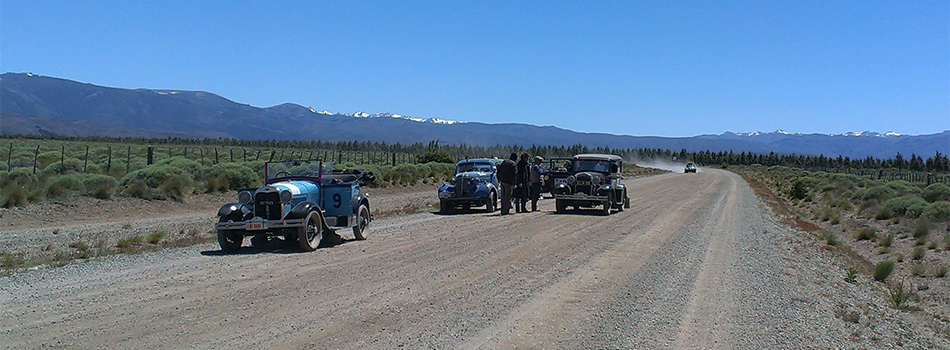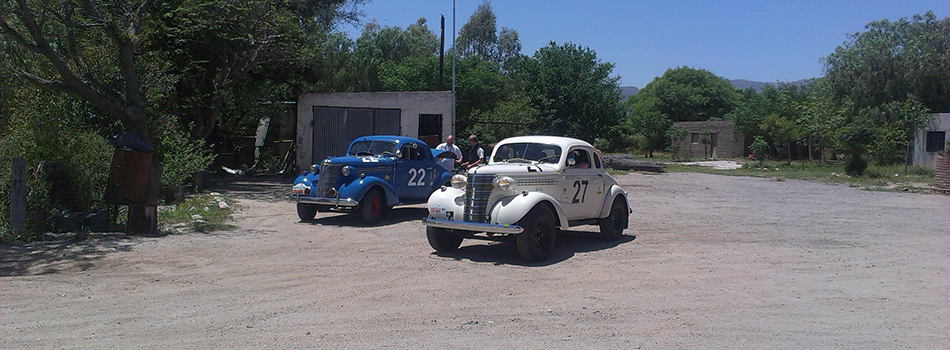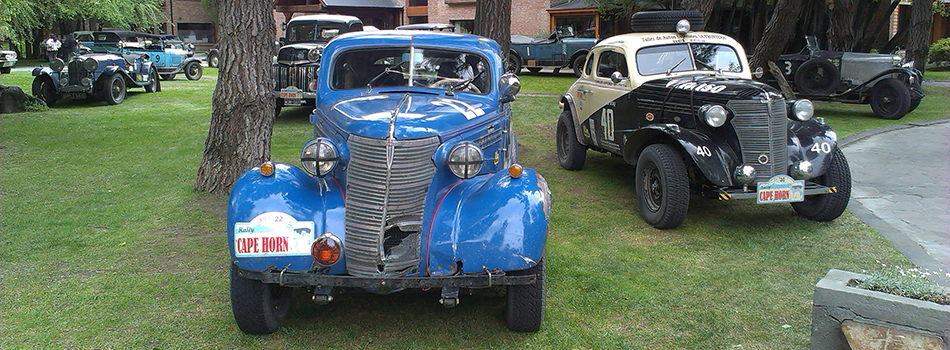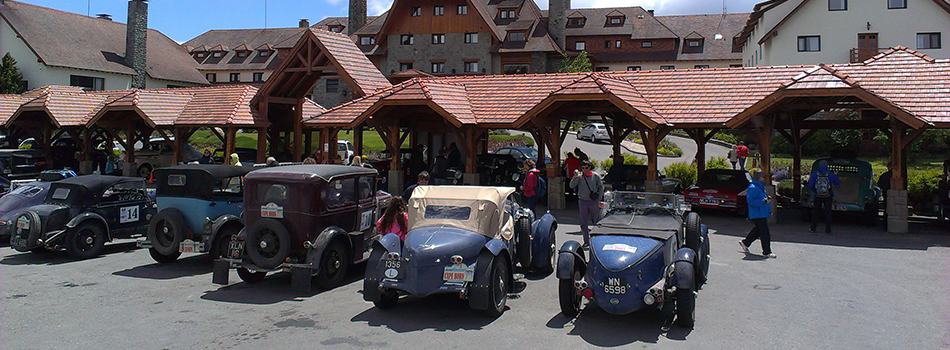DAYS
Vintage Cape Horn 2013
An epic 6,000 kilometre adventure drive from Buenos Aires to Cape Horn through Argentina and Chile. 2013
Vintage Cape Horn – November 2013
Flagged away from the vibrant city of Buenos Aires – where they really do dance Tango in the streets, the rally heads West across the beautiful green Pampas, via Rosario and into the famous vineyards of Mendoza. Then it is over the Andes, via some breathtaking mountain passes, and into Chile, with a chance to explore the cosmopolitan city of Santiago.
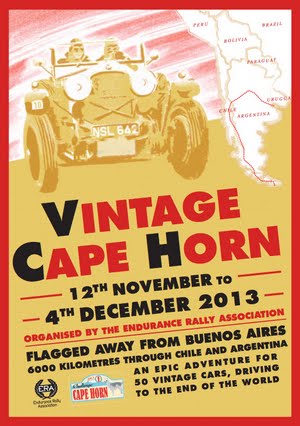 Heading south towards the Chilean Lake district and the lovely resort town of Pucón, bringing us beneath the snow capped active volcano of Villarrica. This gives us a chance to drive through some beautiful national parks en-route to the Argentinian holiday town of San Carlos de Bariloche, surrounded by beautiful lakes and forests.
Heading south towards the Chilean Lake district and the lovely resort town of Pucón, bringing us beneath the snow capped active volcano of Villarrica. This gives us a chance to drive through some beautiful national parks en-route to the Argentinian holiday town of San Carlos de Bariloche, surrounded by beautiful lakes and forests.
Snaking across the spine of the Andes, we then follow the famous El Camino de los Siete Lagos (Road of the Seven Lakes), through stunning scenery, heading ever South. Now the rally enters Patagonia proper, with huge skies, wide open spaces, epic sunsets and some wonderful graded roads. A stop to visit the world famous Moreno Glacier is an absolute must as we enter the Los Glaciers National Park, the myriad shades of blue within this huge Glacier are astounding. Next is the breathtaking Torres del Paine National Park, these gravel roads travel through the heart of this rugged place, full of towering peaks and glacial lakes. After crossing the Magellan Straits we continue to the end of the epic Ruta 40 and arrive in frontier port of Ushuaia, otherwise known as the “Fin del Mundo”. Next place South from here? Cape Horn… Antarctica…?
This promises to be an epic 6000 kilometre adventure for 50 Vintage and Classic cars. Using a tulip route book there will be no need for GPS navigation or plotting the course on maps, the route is suitable for novices and experienced crews and we will help you every step of the way with your vehicle and personal preparations. The entry is open to Vintage or Classic cars that are able to maintain a constant average speed of 80kph/50mph to ensure that they can keep up with the rally timetable.
We will run Medal sections on gravel roads for competitive crews with a Tarmac route for those more interested in touring. The choice is yours each day which route you drive. Knowing the capabilities of early cars, there will be no night driving and the daily distances will be reasonable, our two longest sections are 600kms but we have a rest day straight after – so plenty of time to recover and enjoy the group dining which ensures this will be a highly social event.
Vintage Cape Horn – Route Survey – Part One
During November 2012 Kim Bannister and Duncan Milligan are exploring South America to find the best roads and make the route notes for next year’s Vintage Cape Horn. Whenever possible they are sending back reports that provide a flavour of what lies ahead for those who join us next November.
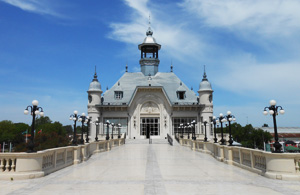 The Art Museum at Tigre
The Art Museum at Tigre
Buenos Aires
The weather in Buenos Aires is bright, hot and sunny – and will be the same when we arrive next November with the cars for the start of Vintage Cape Horn 2013.
Our chosen five-star hotel is only minutes from the port, so we can collect our cars and return to the comfort of the covered parking area for any last minute preparation before the safety checks, scrutineering and other pre-start formalities.
We have also checked out the wonderful start venue at the Art Museum at Tigre in the north of the city. They are very keen to welcome the cars and display them for all to see. Argentina is a car mad country so we can expect some keen spectators to cheer us on our way.
Buenos Aires to Rosario
After the start from Tigre we have a gentle run along the highway to the city of Rosario for our overnight halt. This will get the event away from the Buenos Aires area, home to almost a quarter of Argentina’s population and therefore a very busy place, and on our way west towards the Andes and some of the most stunning scenery you could hope to experience through the windscreen of a vintage car. It’s an easy day, so will also help both the car and crew settle in to the event.
At Rosario we have found a newly renovated race circuit and we are currently in discussions with the owners to see if we can arrange a few hours use for a little fun and competition.
Rosario to Cordoba
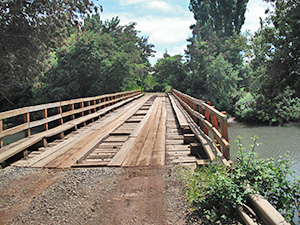 Keep in the Middle
Keep in the Middle
Our hotel in Rosario is close to the highway so it’s an easy get away to either the circuit or the road to Cordoba and the drive west towards the Andes.
From Rosario, another easy-going day as we will use Route 9, the Pan-American Highway, before turning off just south of Cordoba towards Alta Gracia and, if negotiations are successful, another race circuit just south of Cordoba city, at the end the day.
Our hotel for the night is just outside the city centre so there will be time to explore before dinner.
Cordoba to Mendoza
Leaving Cordoba, the route is soon into the hills for the first time, these are not the Andes but a good introduction to what lies in store later in the event.
We have found two lovely, twisty, smooth tarmac sections before a coffee stop at the Parador Condor, which at a height of 2,150 metres will give crews a great chance to see the majestic birds that the restaurant is named after, soaring in the crystal clear skies overhead. After coffee the road drops down through some truly wonderful scenery to the town of Mina Clavero, birthplace of Argentinean rally legend Jorge Recalde.
We also took the chance to explore a lot of gravel roads in the area but these were far too rough to use on this type of event so have made sure we stay on tarmac today.
After leaving Mina Clavero the road flattens out and the rest of the day will be spent on smooth, fast and almost traffic free roads, all the truck traffic heads south to join a motorway towards the Chilean border, to our overnight halt in Mendoza. Mendoza seems so much more relaxed than Cordoba.
Our hotel is in the city centre so exploring is easy. Mendoza also offers the event its first rest day and a number of activities will be available including a visit to one of the world famous vineyards in the area
Mendoza to Santiago
Leaving Mendoza there is only one choice of road to cross the border into Chile. Route 7 is a lovely smooth tarmac road which climbs its way steadily to over 3000 metres before reaching the border post at Los Libertadores. Our route to the border also passes Mount Aconcagua, the highest on the continent, on your right. We are lucky today, the weather is hot and sunny with clear blue skies so the mountains look wonderful.
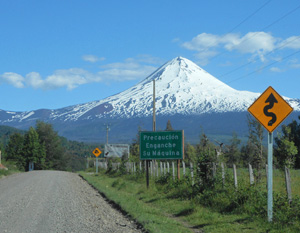 Spectacular Roads and Glorious Scenery
Spectacular Roads and Glorious Scenery
At the border crossing point the usual formalities were dealt with quite quickly, just remember to bring a pen with you to fill in the various forms required. The Argentina Out and Chile In windows are next to each other. The Chilean customs people were very thorough and searched all our baggage; they are particularly concerned with the import of food stuffs and plants.
Once across the border the road descends through an amazing series of hairpin bends with great views dropping very quickly from the 3225 metres at the border point to below 2000 metres into the town of Los Andes where we join the highway south to Santiago.
On our way south we have found a lovely section of 19kms in the hills, a new tunnel on the highway goes under the pass that we crossed. The road is currently gravel for about 9kms but we spoke to a road work crew who assured us the road will be fully paved by the time we arrive next year. Any crew who chooses to avoid the section can just continue on the highway.
Our hotel for the next two nights will be the Hyatt Grand and it lived up to expectations, great food, good wine and excellent service.
On the rally crews will have another rest day to enjoy the city and various other trips on offer but our route survey work continues so we push on south.
Santiago to Chillan
We left Santiago and headed south on Route 5. Leaving Santiago proved to be very easy, if a little slow at times. Once on Route 5 we tried various options in the back roads either side if the highway to break the journey up and have found a lovely lunch location in Santa Cruz. The hotel is owned by a car enthusiast who also has his own vineyard and museum which we are trying to arrange a visit.
After lunch a lovely run through the quiet Chilean back roads takes us back to Route 5 to continue south before we once again turned off to explore some of the gravel roads in the area.
Two optional sections were found, the first on a beautiful track through a forest area the second a little stonier but still good and taking us back to the highway.
A further short section on Route 5 took us to San Carlos where we again headed east to find a way through the countryside avoiding the long trip down and through the city of Chillan on our way to the hotel in the ski resort of Termes de Chillan.
After inspecting a number of possible routes we found what we considered to be the best, although there were a few rough patches, but the distance and time over the journey through Chillan was worth it. Any crew who wants to stay completely on tarmac wherever possible will be given the route through the city.
Our hotel for the night will be the Gran Hotel at Termes de Chillan and our inspection found a lovely swimming pool, spa, and hot baths area together with a well stocked bar and traditional restaurant, all this with fantastic views of the mountains, a really lovely location.
Chillan to Pucon
We left Termes de Chillan and began to explore the minor roads to the west of the resort as I wanted to find a way through the countryside without driving the 82 kms back to the city of Chillan and then heading south on Route 5, the only other real option.
We tried a number of roads again before finding a short cut which uses some bumpy gravel but taken at a low speed will not be a problem and will save a lot of time on the day.
Heading south on the N59 we found a gravel loop to use as an optional Medal Section, those crews wanting to avoid this can simply continue along the tarmac main road, before having to re-join Route 5 as this is the only road which would take us south to where we needed to be.
At the town of Victoria we headed east to explore the area and found what must be one of the most wonderful roads I have ever driven.
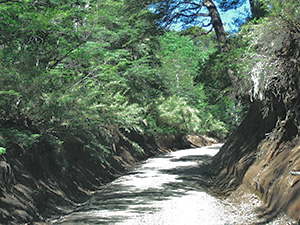 On the Volcano Trail
On the Volcano Trail
The road through the Parque Nacional Conguitto takes you around Volcano Llaima, which last erupted in 2008, through a lava field and a forest of the tallest Monkey Puzzle trees I have ever seen. The views are amazing but the road is only for those who want an adventure. It is unsurfaced with constant changes between stony, sandy and occasionally muddy surfaces with twists and turns and ups and downs. Once out of the forest area and into the southern lava field the road opens out and the surface changes again into a beautifully graded gravel track with sweeping bends before joining tarmac.
Today we are looking for an optional route for those who do not want to take their cars through the park but also do not want to take the only all tarmac option on Route 5.
After an early breakfast we headed east through the town of Vilcun and into Cherquenco to try and find a track shown on two versions of the maps I had but not on the other. The two versions were correct and we found ourselves on a newly graded gravel road to the west of Volcano Llaima which joined our original route near the town of Cunco giving us the third option to consider.
From Cunco we then used a bit of guesswork to find the correct road out of town to the south to find a way through towards Villarrica and our hotel for the night. The roads were clearly signposted and recently graded, which made them a little stony and corrugated uphill but generally good and it was a lovely drive passing Lake Colico, with views of Volcano Villarrica in the distance.
The tarmac roads returned before we reached the town of Villarrica and then on towards the hotel the event will be using for the overnight stay. The Villarrica Park Lake Hotel is a five-star luxury hotel on the banks of Lake Villarrica with stunning views from the rooms, bars and restaurant.
Tomorrow we head back into Argentina.
Pucon to Bariloche
Spending a little more time in each area and exploring the back roads really worked today as we found a superb 16kms gravel loop to start the day before joining the main road and the run to the border. The road is tarmac for most of the way then becomes gravel which is bumpy in places before reaching the Chilean border post.
The border officials were friendly and very efficient; just make sure you have a pen and your car documents to fill out all the forms. We were the only vehicle leaving so progress was very swift.
Having left the Chilean border post we drove a little further along the gravel track to the Argentine side and again the officials were both friendly and efficient. Our only hold up was that we were second in the queue to four attractive young ladies crossing into Chile. At the Argentine post both people and vehicles arriving and leaving are dealt with in the same hall, and clearly the young border guard was far more concerned with making them happy than worrying about us. Once we were dealt with however progress was very quick and we drove into Argentina.
The road surface changed as we crossed the border with the gravel becoming a little smoother and then becoming tarmac after a few kilometres.
Again some exploring further along the route provided us with a wonderful 9 kms section through the mountains, all uphill bends and fabulous views.
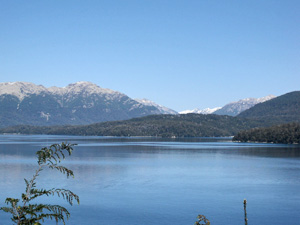 Approaching Bariloche
Approaching Bariloche
As we headed south we had a choice to make, do we take the gravel Route 63, a shorter but much rougher route, or the 234 which promised a much better run to the finish but was slightly longer. As the event is for pre-war cars we opted for the longer, prettier and smoother route and this was definitely the correct choice. The road sweeps and swoops through some wonderful scenery and finally emerges in the lake district meaning for the last 70kms to Bariloche you always have a lake view on the right, simply stunning.
The road is currently being improved and there was a stretch of nearly 30kms which is being worked on and will almost certainly be tarmac by the time the event arrives in the area. Even if it has not been finished the surface is good, with occasional bumps, but will be a lovely drive in an old car.
We finally arrived at our hotel for the next two nights, just as it will be on the event, the world famous Llao Llao Hotel, a member of the Leading Hotels of the World group.
This hotel is set on the side of a lake and crews will have to make the choice of either a room in the traditional part of the hotel, smaller rooms, luxuriously furnished but with no air conditioning and closer to the main public areas of the hotel or in the new wing which has bigger rooms all with a lake view and air conditioning but there is a long walk to the main areas.
Tomorrow we don’t have a rest day, as the rally will, but we will use the extra day to explore every road in the Bariloche area to make sure we are using the best available.
Bariloche to Esquel
I have read that some people judge the quality of the hotel by their Muesli but not being a Muesli muncher I have always felt the breakfast omelette is a good measure and the omelettes cooked for you at the Llao Llao Hotel are wonderful. In fact the whole breakfast buffet is a great way to start your day.
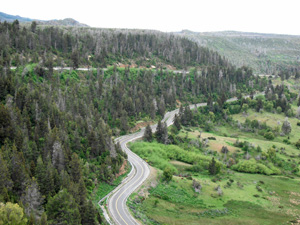 The Road to Esquel
The Road to Esquel
Leaving the hotel we used the circuit of twisty tarmac roads that surround the Llao Llao area and then headed back towards Bariloche. The town is a tourist centre and gets very busy at this time of year so we headed south east avoiding the town although this did mean using 3kms of gravel just before joining Route 40.
On the event we can have two very different routes. One for those more interested in touring will use the all tarmac Route 40. This road sweeps and swoops through some lovely scenery before the landscape flattens out as you near the overnight stop in Esquel.
For those looking for a little more adventure the other route option might appeal. We started with a 25kms gravel loop near El Foyel followed by a fantastic 47kms drive using the all gravel Route 6 through the hills to El Maiter.
We then drove a lovely new road to re-join Route 40 for the short run south to Parque Nacional Los Alerces, stopping at a checkpoint where they wanted to disinfect any fishing equipment we had on board, you have been warned. This also gave us a chance to try and check the road conditions before we moved on.
The drive through the park was wonderful, a few bumpy patches but generally good gravel and there were signs of the road being worked on and improved as we neared Esquel. Although there is an all tarmac alternative I think the scenery makes this drive worthwhile.
As we left the park we joined a new tarmac road which twisted and turned as it dropped into the Esquel and our hotel for the night.
Esquel is close to the half-way point in our route survey. We’ll post more soon.
Kim Bannister
Vintage Cape Horn – Route Survey – Part Two
Esquel to Coyhaique
When the route was first planned a decision had to be made about where to go from Esquel. The choices were to continue down Route 40 in Argentina crossing one of the flattest and most uninteresting parts of the country,or to go back into Chile and the mountains and explore new territory – an easy call to make, we decided to go to Chile.
From Esquel we headed south west, joining an excellent gravel road and crossing the border at Paso Futaleufu. We were the only car crossing so formalities were quick and the officials both friendly and efficient. From the border we joined tarmac for 10 kms to the village of Futaleufu then found the 231 road out of the village and started a wonderful scenic drive on good gravel roads.
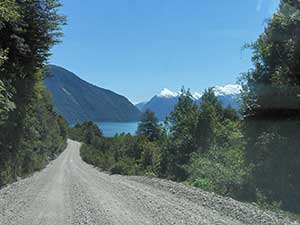 On the Carretera Austral
On the Carretera Austral
Road numbers 231 and 235 led us to the famed Carretera Austral, the road started in the 1970’s to join the more remote towns of the western part of Chile together.
We followed the lovely sweeping road for a few kilometres and stumbled across a café which showed a sign saying “English Spoken Here”, this was too good to be true. As it turned out the person who spoke English only works during the summer holidays but Duncan was able to ask the lady if she could make us some lunch and a fabulous vegetable soup with home made bread was produced. I have her phone number and she promises to do the same when the rally goes that way next year.
As we were running late we decided to stop near the town of Puyuhuapi at some log cabins. The manager spoke excellent English, as well as German and his natural Spanish, and has given me his phone number so we can check on the road conditions before we drive through next year. The next morning we completed the long drive to Coyhaique through the wonderful scenery of the Parque Nacional Quelat and, although there is over 250kms of gravel roads on the drive, it is so much better than the scenery on the other side of the border in Argentina, so I think it is worth the effort. There is no tarmac alternative today- but there will be plenty of time to make the journey on the event. Optional medal sections will be part of the day but you can choose to do these or simply carry on driving through.
Coyhaique is the largest town in the region, it still only has 40,000 inhabitants, and has a nice centre with a few restaurants and bars to visit before dinner.
Our hotel is new and the best in town so it will be a pleasant place to stay after a long day.
Coyhaique to Los Antiguos
As we left Coyhaique we were once again faced with a choice of possible routes- all of them including an amount of gravel roads.
After much thought we decided to head south using the tarmac road for the first 114 kms to a small border post at Puerto Ibanez. The scenery as we drove through the Reserva Nacional Cerro Castillo was wonderful and our last taste of the mountains for a little while as we headed back into Argentina
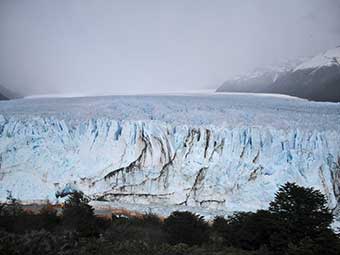 The Perito Moreno Glacier
The Perito Moreno Glacier
The border at Puerto Ibanez was so small that we almost drove past it. We stopped and went into the office to be welcomed by a single Chilean official who very quickly dealt with the paperwork and waved us on our way. Once again we had chosen a nice quiet border crossing which will help us on the rally.
The Argentinean border post is 20 kms further on and we had to cross an often quite rough gravel road to reach it, again as there is no alternative all tarmac route we will all have to go this way and plenty of time will be allowed.
From the border we had to cover 95 kms on a reasonable gravel road to the tarmac at Perito Moreno.
There are very few hotel rooms available in this area so we are arranging a quality tented camp for the night in the town of Los Antiguos very close to the Chilean border.
We chose the town because the camp site is on the shores of Lake Buenos Aires with the chance to stroll on the beach as the sun goes down before dinner. Our host for the camp, Billy Zebalos, is an expert on trekking expeditions so we expect everyone will enjoy their night under canvas. Billy is bringing a large supply of beer, local wine and spirits, and promises a real Argentinean BBQ, there are two buildings on the site, one to act as the restaurant the other as the bar so it promises to be a lively evening under the stars.
Los Antiguos to El Calafate
This is going to be the longest day of the rally, with no other route possible than using Route 40 for much of the way. This road has been improved recently and much of it is good, fast tarmac so the kilometres are covered quickly.
The road becomes gravel after 300 kms and we had a choice of roads to take. We used a shorter route with a good gravel surface through some hills which will allow an optional Medal Section to be run before we re-join Route 40 and the tarmac road to El Calafate.
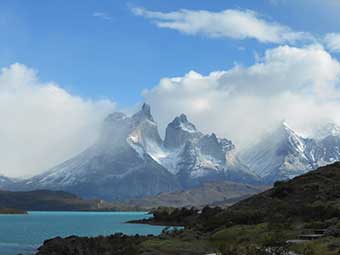 Torres del Paine
Torres del Paine
After a long day it was great to arrive at the hotel we will use for two nights on the rally the 5* Los Alamos, no wonder the hotel was the winner of a Trip Advisor award as the service, food and facilities are wonderful.
The rally gets a rest day in El Calafate so crews can enjoy one of the many trips available, a round of golf at the hotel’s course, a gentle wander around the town or, the best of all, a visit to the incredible natural wonder that is the Perito Moreno Glacier.
The glacier is 70 kms from the town and takes about 90 minutes to drive there, the last 30 kms in the national park being very twisty and slow but with stunning views.
There are not many views more breathtaking than the first sight of this amazing glacier- one of the few in the world that is still advancing. The number of different shades of blue was incredible and we were lucky enough to be there as a sheet of ice broke away, the noise and spectacle was just awe inspiring.
We have made some route notes for any crew who wants to drive their own cars to the glacier or you can even take a boat trip right up to the ice face, this can be organised for you in advance.
El Calafate to Torres del Paine
Rather than head east across the flat steppes of Argentina we decided to head west and back into Chile once more to visit the world renowned Torres del Paine National Park.
From El Calafate it is an easy run across good fast tarmac roads for the first 100 kms before we turned right onto a lovely gravel road which cuts across country for 71 kms and will make a great optional medal section.
There is an all tarmac alternative which is 80 kms longer but the road is smooth and fast so times will be about the same.
From the point that the choice of routes meet we continued on the tarmac for another40 kms before turning off on a gravel road to the border post of Argentina.
We were one of only three vehicles, all crossing from Argentina into Chile, and the border guards were as efficient and friendly as any we have met on the whole journey. We were through in about five minutes and drove the final few kilometres to the Chilean border at Cerro Castillo.
We met up again with the other vehicles crossing from Argentina and we all carried our various suitcases and other bags into the customs hall to be x-rayed. The Chilean customs are very strict on what can be taken in to the country so expect to have your luggage searched at each entry point, we found that the searches were always carried out in a friendly and helpful manner so do not expect any problems on the event.
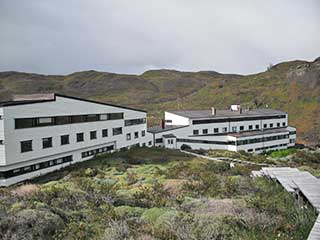 The World Famous Explora Hotel
The World Famous Explora Hotel
Having taken care of the necessary formalities we entered Chile and joined a lovely tarmac road and headed into towards the park entrance.
The road turned to gravel after a few kilometres, but it is the best gravel we have had on the whole route survey so progress was fast. Another medal section will be run on these roads before we enter the park.
The drive for the next 26 kms to the hotel was just great fun. Smooth gravel, sweeping bends, hills, views, lakes, animals, just about everything you would want on an adventure drive.
We finally arrived at our hotel for the next two nights, just as we will on the rally, the world famous Explora Hotel. Set on a hill overlooking the Salto Chico falls the hotel is an amazing building with luxurious rooms, stunning views, excellent food and wine and helpful and friendly staff. This place really is amazing and a destination in itself.
Your rest day will be filled by the team on site who can offer numerous treks, boat trips, horse rides or suggestions for lovely drives within the park boundaries. Of course you can also relax in the spa-including outdoor, lakeside hot tubs, if you prefer before a cocktail in the bar before another magnificent dinner.
Torres del Paine to Punta Arenas
We very reluctantly checked out of the Explora Hotel and left Torres del Paine on a very typical Patagonian spring morning with snow in the wind as we headed south.
We left the park and immediately found a lovely gravel road for a timed Medal Section leading to the main tarmac road and our journey towards Punta Arenas.
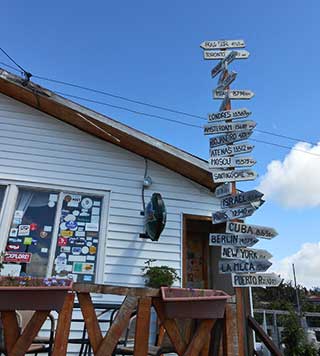 Cafe Patagon
Cafe Patagon
As many crews will be needing fuel by now we decided to take a short detour off the main road into the town of Puerto Natales and there we found three fuel stations and some shops and cafes to stock up on essentials for the day ahead.
One discovery we did make was the Café Patagon which will make a great coffee stop and passage control just over half way through the day.
The café is visited by many travellers and there are a number of signs with the distances to far flung places outside and many group stickers all over the windows and walls inside. The coffee was good and hot and the sandwiches freshly made to order.
After the stop it was a short trip of about 100 kms to our overnight halt in Punta Arenas, the southernmost city in Chile.
Tomorrow we are going to look at two possible ferry crossings into Tierra del Fuego for the last two days of our epic trip and we can then decide which would make the most interesting journey for the crews.
Both Duncan and I have felt entirely justified in our decision to spend more time in Western Patagonia, the simple, quick and easy border crossings between Argentina and Chile have made criss-crossing the mountains and national parks a joy, and allowed us to experience some truly breath-taking scenery, whilst at the same time avoiding much of the dull, flat landscape further East.
Punta Arenas to Rio Grande
We headed north from the hotel and after 5kms found the ferry terminal for the crossing to Porvenir on Tierra del Fuego. This crossing of the Magellan Straits will take just over 2 hours and will take the cars to the westernmost point of Tierra del Fuego.
As we had not booked ourselves onto the ferry we decided to drive the more regularly taken route to use the shorter ferry crossing at Punta Delgarda, this way we would have notes for both routes and could then decide later which was the best alternative.
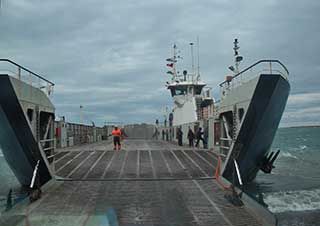 The Magellan Straits Ferry
The Magellan Straits Ferry
The run to the ferry was an easy, flat 170kms drive on a smooth tarmac road. At the crossing point we waited for the ferry to arrive and watched with admiration as the captain negotiated his way across the fairly rough water to dock at exactly the right point to let the cars and trucks off.
The traffic crossing into Tierra del Fuego was much lighter than that returning to the mainland and we were very quickly loaded and on our way.
You pay on board for the crossing but cannot reserve places so we need to look at how this would affect the timing of the event.
One added bonus of the journey was the school of dolphins that swam alongside for almost the entire crossing.
Getting off the ferry was as easy as getting on with no formalities and we headed south towards the town of Cerro Sombrero where we planned to spend the night so we could have time to explore the roads towards Porvenir and the alternative ferry journey.
The road west from Porvenir was good gravel and runs alongside the sea making it a far nicer drive than the road from the north, it also gave me a chance to look at an optional medal section which can be easily avoided, no tarmac road to choose though so we will all have to use the gravel.
We drove to the point where our two route options met and then headed back to our hostel for the evening and dinner in the company restaurant, Cerro Sombrero is a town built for and used by a gas exploration company, with a very basic “meat or fish” choice but they did not really recommend the fish.
After a quick breakfast we returned south to where we had left our route the previous day and continued on the gravel roads to the border crossing at San Sebastian.
This crossing point is the only one open between the Argentinean and Chilean parts of the island so is a well used border and very efficient.
After entering Argentina for the final time on this trip we headed south to our overnight halt in a new hotel in the town of Rio Grande on the Atlantic coast.
Rio Grande to Ushuaia
Even on the final day of the trip we decided to try and find a medal section for those who want a little competition.
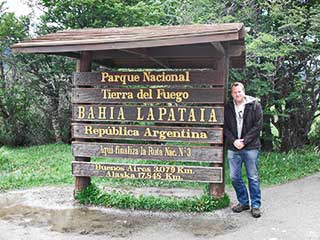 Journey’s end at Tierra del Fuego
Journey’s end at Tierra del Fuego
There is a very nice race circuit at Rio Grande and this is going to be looked at by our agent in the area to see if we can use it but we also found a superb gravel road section through the countryside with an easy all tarmac alternative route so will definitely add this to the schedule.
The rest of the route to Ushuaia is along a good tarmac road which becomes more interesting as you get closer to the town as the road enters the mountains for the final time.
The finish location is currently being looked at and the necessary permissions are being requested but we hope to have a great photo opportunity for all crews at the end of this epic journey.
Our final hotel is set on the Beagle Channel and is close to both the airport and the ferry terminal for any crews who plan to stay on and enjoy a trip to Antarctica.
Just a few final notes about our route survey;
Although the route for the rally is just over 6000 kilometres Duncan and I have driven over 9000 kilometres since leaving Buenos Aires as we have tried many different roads to try and ensure we have the best possible route for the event.
We have had only one puncture and that was in the car park in Cordoba. We have only used normal van tyres for the entire trip, run at the manufacturers recommended pressures, but this is also a testament to Duncan’s driving who has been careful not to slide the car around on the gravel roads.
Tomorrow I fly back to Buenos Aires then on to the UK to start again on future events. Duncan is taking his time to drive the hire car back to Buenos Aires but will be home in time for Christmas… phew!
Kim Bannister
| Day | Date | Nightstop | Country | Kms |
| 12th November 2013 | Car Collection | Argentina | ||
| 13th November 2013 | Briefing & Scrutineering | Argentina | ||
| 14th November 2013 | Buenos Aires | Argentina | ||
| 01 | 15th November 2013 | Rosario | Argentina | 320 |
| 02 | 16th November 2013 | Cordoba | Argentina | 470 |
| 03 | 17th November 2013 | Mendoza | Argentina | 630 |
| 04 | 18th November 2013 | Mendoza (Rest Day) | Argentina | |
| 05 | 19th November 2013 | Santiago | Chile | 370 |
| 06 | 20th November 2013 | Santiago (Rest Day) | Chile | |
| 07 | 21st November 2013 | Termas de Chillán | Chile | 550 |
| 08 | 22nd November 2013 | Pucón | Chile | 530 |
| 09 | 23rd November 2013 | Bariloche | Argentina | 420 |
| 10 | 24th November 2013 | Bariloche (Rest Day) | Argentina | |
| 11 | 25th November 2013 | Esquel | Argentina | 390 |
| 12 | 26th November 2013 | Coihaque | Chile | 500 |
| 13 | 27th November 2013 | Los Antiguos | Argentina | 275 |
| 14 | 28th November 2013 | El Calafate (Transit Day) | Argentina | 680 |
| 15 | 29th November 2013 | El Calafate (Rest Day) | Argentina | |
| 16 | 30th November 2013 | Torres Del Paine | Chile | 290 |
| 17 | 1st December 2013 | Torres Del Paine (Rest Day) | Chile | |
| 18 | 2nd December 2013 | Punta Arenas | Chile | 360 |
| 19 | 3rd December 2013 | Rio Grande | Argentina | 235 |
| 20 | 4th December 2013 | Ushuaia – Finish and Prize Giving Dinner | Argentina | 280 |
| Num | Participants | Motorcar | Engine Size |
| Vintageant (pre ’41) up to 3000cc | |||
| 1 | Arthur Manners(GB) / Anna Manners(GB) | 1927 – Oldsmobile 30E | 2998 |
| 5 | Nicholas Phillips(GB) / Barbara Phillips(GB) | 1932 – Alvis Speed 20 | 2500 |
| 6 | Nigel Gambier(GB) / Hugo Upton(GB) | 1934 – Lagonda T7 | 3000 |
| 7 | Gerard Besson(F) / Marie-Odile Besson(F) | 1939 – Citroen Traction Avant | 1991 |
| 16 | Penny Rawlings(GB) / Geoffrey Rawlings(GB) | 1934 – Talbot AV 105 | 2969 |
| Vintageant (pre ’41) over 3000cc | |||
| 2 | Jean Steinhauser(LU) / Anne Steinhauser-Collard(B) | 1937 – Bentley Derby 4¼ | 4250 |
| 3 | Charlie Bishop(GB) / Nellie Bishop(GB) | 1925 – Vauxhall 30/98 | 4250 |
| 4 | Charles Stuart-Menteth(GB) / Missy Stuart-Menteth(GB) | 1924 – Vauxhall 30/98 | 4250 |
| 8 | Robert Abrey(GB) / Jane Abrey(GB) | 1925 – Bentley 3-4½ | 4497 |
| 9 | Rupert Marks(GB) / Blake Dorrington(GB) | 1928 – Ford Model A | 3300 |
| 10 | John Raker(GB) / Melinda Raker(GB) | 1929 – Ford Model A | 3285 |
| 11 | David Cooley(USA) / Ross Lilleker(GB) | 1929 – Ford Model A | 3285 |
| 12 | Leslie Roy(USA) / Rand Elliott(USA) | 1935 – Ford Model B Phaeton | 3200 |
| 14 | Olaf Pothoven(NL) / Monica Pothoven-Fels(NL) | 1935 – Bentley Derby | 3500 |
| 15 | Jan Woien(N) / Jan Hansen(N) | 1935 – Alvis Speed 25 | 3498 |
| 17 | Andrew Bailey(IRL) / Philippa Spiller(IRL) | 1928 – Bentley 3-4½ | 4500 |
| 18 | Martin Hunt(GB) / Olivia Hunt(GB) | 1927 – Bentley Le Mans | 4500 |
| 19 | Francis Galashan(GB) / Michael Brooks(GB) | 1938 – Alvis 4.3 Tourer | 4387 |
| 20 | Catherine d’Andrimont Janssens(B) / Ms D’Andrimont(B) | 1937 – Chevrolet Coupe | 3600 |
| 22 | Daniel Day(USA) / Michael Day(USA) | 1938 – Chevrolet Coupe | 4000 |
| 23 | Clinton Smith(GB) / Trevor Finn(GB) | 1938 – Chevrolet Coupe | 3860 |
| 24 | David Williams(GB) / Sadie Williams(GB) | 1938 – Chevrolet Fangio Coupe | 4000 |
| 25 | Bill Dolsen(USA) / Joe Farina(USA) | 1939 – Chevrolet Master Deluxe | 4000 |
| 26 | Alain Grisay(B) / Edouard Grisay(B) | 1940 – Chevrolet Coupe | 3600 |
| 27 | Bill Shields(USA) / Alex Schoenauer(USA) | 1938 – Chevrolet Coupe | 3600 |
| 28 | Udo Bichler(ZA) / Antony Edwards(GB) | 1939 – Buick Coupe | 4000 |
| 29 | Bruce Selbie(NZ) / Alexander Robertson(NZ) | 1938 – Chrysler P6 | 3300 |
| 40 | Pamela Lyford(USA) / Chuck Lyford(USA) | 1938 – Chevrolet Fangio Coupe | 4000 |
| Classic cars (pre ’75) | |||
| 21 | Paul Merryweather(GB) / Sandra Merryweather(GB) | 1974 – Mercedes 450 SL | 4500 |
| 30 | Christian Dumolin(B) / Regine Dumolin-Petillion(B) | 1966 – Ford Mustang GT 289 Cabrio | 4660 |
| 31 | Michael Maedel(A) / Roy Haddad(GB) | 1953 – Jaguar XK120 OTS | 3800 |
| 32 | David Harrison(GB) / Julia Harrison(GB) | 1959 – Porsche 356A | 1600 |
| 33 | Luc Janssens(B) / Alfredo Uboldi(RA) | 1947 – Ford Pick-Up | 3500 |
| 34 | Alastair Caldwell(GB) / Laurel Smith(USA) | 1968 – Mercedes 280 SL | 2778 |
| 35 | Jan Van Gemert(NL) / Marion Van Gemert(NL) | 1965 – Ford Mustang | 4735 |
Overall Results
The final overall classification of the 2013 Vintage Cape Horn rally
December 04, 2013
| Num | Crew Car |
Leg Total |
Overall Total |
o/a pos’n |
Cls pos /Cls |
| Vintageant Category cars | |||||
| 40 | Pamela Lyford / Chuck Lyford Chevrolet Fangio Coupe |
0:11:05 | 0:44:04 | 1 | 1/c2 |
| 23 | Clinton Smith / Trevor Finn Chevrolet Coupe |
0:10:45 | 0:45:06 | 2 | 2/c2 |
| 14 | Olaf Pothoven / Monica Pothoven-Fels Bentley Derby |
0:10:41 | 0:45:12 | 3 | 3/c2 |
| 18 | Martin Hunt / Olivia Hunt Bentley Le Mans |
0:11:19 | 0:51:08 | 4 | 4/c2 |
| 15 | Jan Woien / Jan Hansen Alvis Speed 25 |
0:11:09 | 0:51:41 | 5 | 5/c2 |
| 17 | Andrew Bailey / Philippa Spiller Bentley 3-4½ |
0:12:14 | 0:59:00 | 6 | 6/c2 |
| 20 | Catherine D’Andrimont Janssens / Stephanie D’Andrimont Chevrolet Coupe |
0:13:21 | 1:02:06 | 7 | 7/c2 |
| 2 | Jean Steinhauser / Anne Steinhauser-Collard Bentley Derby 4¼ |
0:12:56 | 1:02:10 | 8 | 8/c2 |
| 12 | Leslie Roy / Rand Elliott Ford Model B Phaeton |
0:12:13 | 1:02:12 | 9 | 9/c2 |
| 25 | Bill Dolsen / Joe Farina Chevrolet Master Deluxe |
0:12:20 | 1:03:01 | 10 | 10/c2 |
| 26 | Alain Grisay / Edouard Grisay Chevrolet Coupe |
0:12:45 | 1:03:03 | 11 | 11/c2 |
| 5 | Nicholas Phillips / Barbara Phillips Alvis Speed 20 |
0:11:38 | 1:04:17 | 12 | 1/c1 |
| 22 | Daniel Day / Michael Day Chevrolet Coupe |
0:12:38 | 1:13:47 | 13 | 12/c2 |
| 3 | Charlie Bishop / Nellie Bishop Vauxhall 30/98 |
0:14:04 | 1:14:56 | 14 | 13/c2 |
| 8 | Robert Abrey / Jane Abrey Bentley 3-4½ |
0:12:27 | 1:15:19 | 15 | 14/c2 |
| 1 | Arthur Manners / Anna Manners Oldsmobile 30E |
0:14:06 | 1:22:44 | 16 | 2/c1 |
| 27 | Bill Shields / Alex Schoenauer Chevrolet Coupe |
0:11:11 | 1:37:01 | 17 | 15/c2 |
| 4 | Charles Stuart-Menteth / Nicola Stuart-Menteth Vauxhall 30/98 |
0:13:58 | 2:18:35 | 18 | 16/c2 |
| 10 | John Raker / Melinda Raker Ford Model A |
0:15:22 | 2:58:58 | 19 | 17/c2 |
| 7 | Gerard Besson / Marie-Odile Besson Citroen Traction Avant |
1:13:45 | 7:41:24 | 20 | 3/c1 |
| 9 | Rupert Marks / Blake Dorrington Ford Model A |
0:13:03 | 8:55:25 | 21 | 18/c2 |
| 6 | Nigel Gambier / Hugo Upton Lagonda T7 |
0:14:27 | 9:05:09 | 22 | 4/c1 |
| 29 | Bruce Selbie / Alexander Robertson Chrysler P6 |
2:15:00 | 13:39:34 | 23 | 19/c2 |
| 24 | David Williams / Sadie Williams Chevrolet Fangio Coupe |
2:36:00 | 14:36:34 | 24 | 20/c2 |
| 28 | Udo Bichler / Antony Edwards Buick Coupe |
2:33:00 | 21:21:00 | 25 | 21/c2 |
| 11 | David Cooley / Ross Lilleker Ford Model A / (rental car) |
3:30:00 | Touring | ~ | ~ |
| 16 | Penny Rawlings / Geoffrey Rawlings Talbot AV105 / (rental car) |
3:30:00 | Touring | ~ | ~ |
| 19 | Francis Galashan / Michael Brooks Alvis 4.3 / (rental car) |
3:30:00 | Touring | ~ | ~ |
| Classic Category cars | |||||
| 21 | Paul Merryweather / Sandra Merryweather Mercedes 450 SL |
0:10:40 | 0:41:16 | 1 | 1/c3 |
| 34 | Alastair Caldwell / Laurel Smith Mercedes 280 SL |
0:11:07 | 0:42:08 | 2 | 2/c3 |
| 30 | Christian Dumolin / Regine Dumolin-Petillion Ford Mustang GT 289 |
0:10:32 | 0:48:02 | 3 | 3/c3 |
| 32 | David Harrison / Julia Harrison Porsche 356A |
0:12:05 | 1:00:18 | 4 | 4/c3 |
| 35 | Jan Van Gemert / Marion Van Gemert Ford Mustang |
0:13:10 | 1:50:49 | 5 | 5/c3 |
| 33 | Luc Janssens / Alfredo Uboldi Ford Pick-Up |
0:13:10 | 7:18:41 | 6 | 6/c3 |
| 31 | Michael Maedel / Roy Haddad Jaguar XK120 / (rental car) |
3:30:00 | Touring | ~ | ~ |
